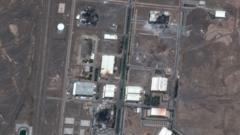Is Iran's Nuclear Program Safe? Global Watchdog Reports No New Damage

Understanding the Current State of Iran's Nuclear Program and Recent Developments
The landscape of international relations and nuclear non-proliferation is continually evolving, particularly as tensions between Iran and Israel escalate. The recent strikes on Iran's nuclear facilities have heightened global concern over nuclear proliferation and the potential for military escalation in the region. Rafael Grossi, the head of the International Atomic Energy Agency (IAEA), has provided critical updates regarding the status of Iran's nuclear capabilities following these attacks. In this article, we will delve into the implications of these developments, the state of Iran's nuclear program, and the broader geopolitical consequences.
Recent Attacks on Iran's Nuclear Facilities
On a recent Friday, Israel launched significant strikes on key Iranian nuclear sites, specifically targeting the Natanz and Isfahan facilities. These attacks were aimed at hindering Iran's nuclear weapons development capabilities, which Israel perceives as a direct threat to its national security. According to Grossi's statements to the IAEA's board of governors, the results of these attacks have been both alarming and revealing.
Details of the Natanz Attack
The Natanz facility, known for its uranium enrichment capabilities, suffered extensive damage. Grossi reported that the above-ground portion of the Pilot Fuel Enrichment Plant (PFEP) was destroyed, which had been utilizing cascades of centrifuges to enrich uranium to 60% purity—a level alarmingly close to the 90% purity required for weapons-grade uranium.
- **Destruction of Infrastructure**: Key electrical infrastructure, including a power supply building, emergency generators, and an electrical sub-station, were also destroyed during the attack.
- **Impact on Underground Facilities**: Despite the above-ground devastation, Grossi confirmed that there were no indications of a physical attack on the underground cascade hall, which houses more centrifuges. However, the loss of power could potentially have caused damage to the centrifuges located there.
Other Affected Sites: Isfahan and Fordo
The Isfahan Nuclear Technology Centre also faced significant damage, with four buildings affected, including:
- A central chemical laboratory
- A uranium conversion plant
- The Tehran reactor fuel manufacturing plant
- A facility aimed at converting uranium hexafluoride to uranium metal, which was under construction
As for the Fordo enrichment plant, reports of damage have been disputed. Although Iranian sources indicated limited damage, Grossi asserted that no visible damage was observed at Fordo or the Khondab heavy water reactor currently under construction. The situation remains complex, with conflicting narratives emerging from both Iranian and Israeli officials.
International Reactions and Implications
The aftermath of the strikes has elicited varied responses from the international community. Iran has vehemently condemned the attacks, labeling them a "blatant violation of international law." Iranian Foreign Minister Abbas Araghchi has called for the IAEA's board to issue a strong condemnation, emphasizing the peaceful intent of Iran's nuclear program.
The Role of the IAEA
As the global nuclear watchdog, the IAEA has been closely monitoring Iran's nuclear activities, assessing radiation levels, and communicating regularly with local authorities to ensure transparency. Grossi has expressed the need for all parties to exercise maximum restraint, cautioning that military escalation could lead to severe consequences, including potential radiological releases that could threaten both human lives and the environment.
Escalating Tensions and Military Responses
The military rhetoric from both Iran and Israel has intensified. The Israeli military has publicly stated that its air campaign will continue, aiming to neutralize what it perceives as an existential threat from Iran's nuclear ambitions. Conversely, Iranian officials have indicated that missile strikes on Israel are a "response to aggression," signaling a potential spiral of retaliation that could further destabilize the region.
The Broader Geopolitical Context
Understanding these developments requires a broader perspective on the geopolitical landscape. The historical context of Iran's nuclear program is essential for grasping the current tensions. Under the 2015 nuclear deal, Iran was restricted from enriching uranium beyond 3.67% purity, a measure designed to prevent the development of nuclear weapons. However, the US's withdrawal from the agreement in 2018 and the reinstatement of sanctions have led Iran to progressively breach these limitations.
Current State of Iran's Nuclear Capabilities
Iran has resumed enrichment activities at various facilities, including Fordo, and has amassed sufficient quantities of 60%-enriched uranium that could potentially be used to create multiple nuclear weapons. As of now, the IAEA has stated that Iran's stockpile could be enough to create up to nine nuclear bombs, raising alarm bells among the international community.
Impact on Global Non-Proliferation Efforts
The situation in Iran poses significant challenges to global non-proliferation efforts. The IAEA's recent declaration of Iran’s non-compliance with its nuclear obligations marks a critical moment in international diplomacy and underscores the urgent need for renewed dialogue and negotiation. The potential for military conflict over nuclear capabilities raises questions about the effectiveness of diplomatic solutions and the future of nuclear non-proliferation treaties worldwide.
Conclusion: The Path Forward
The recent attacks on Iran's nuclear facilities have heightened global concerns regarding nuclear proliferation and regional stability. As the situation continues to evolve, it is crucial for all parties involved to prioritize diplomatic engagement and seek peaceful resolutions to these tensions. The stakes are high, and the consequences of miscalculation could have far-reaching impacts on both regional and global security.
As we reflect on these developments, it's essential to consider the implications for international relations and the future of nuclear non-proliferation. In a world where the threat of nuclear weapons looms large, how can nations work together to foster a more secure and peaceful future?
FAQs
What triggered the recent Israeli strikes on Iran's nuclear facilities?
The strikes were aimed at preventing Iran from developing nuclear weapons capabilities, as Israel perceives Iran’s nuclear program as a direct threat to its national security.
What was the extent of the damage to Iran's Natanz facility?
The above-ground portion of the Pilot Fuel Enrichment Plant was destroyed, along with significant electrical infrastructure. However, the underground facilities reportedly remained intact.
How has Iran responded to the Israeli attacks?
Iran condemned the attacks as a violation of international law and stated that its missile strikes on Israel were a response to aggression.
What does the IAEA say about Iran's nuclear capabilities?
The IAEA has reported that Iran has amassed enough 60%-enriched uranium to potentially create multiple nuclear weapons, raising concerns among the international community.
The world watches closely as events unfold, and the importance of dialogue cannot be overstated. How can nations work together to prevent further escalation and promote peace?
#NuclearProliferation #IranNuclearProgram #GlobalSecurity
Published: 2025-06-16 15:47:03 | Category: world



